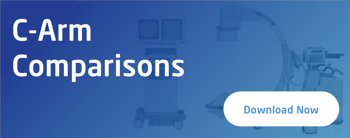So you need a C-Arm. There are countless options out there and it’s an important decision you don’t want to  mess up. You do your research, you take a look at your practice and the procedures you perform and you pinpoint the C-Arm that works best for you. You decide that a refurbished C-Arm will provide the performance (and price!) you need, so you call the dealer, ready to buy. Then that knowledgeable salesman asks you what kind of C-Arm table you want. What?
mess up. You do your research, you take a look at your practice and the procedures you perform and you pinpoint the C-Arm that works best for you. You decide that a refurbished C-Arm will provide the performance (and price!) you need, so you call the dealer, ready to buy. Then that knowledgeable salesman asks you what kind of C-Arm table you want. What?
Yup, you need a C-Arm Table to go with your wow-y, zowie new C-Arm. But fear not! There are three types of C-Arm tables that are ideal, and here’s what you need to know:
Fixed-Height C-Arm Table
The name says it all: it’s a four-legged table on wheels, complete with a padded top. It can’t be adjusted in any way. Not height. Not anything. However, if you don’t need to move your patient around during a procedure, or if you think you can get by by adjusting the C-Arm as opposed to the table, then this table can work for you. However, if you have patients that need assistance getting onto the table, then a fixed height table won’t work for you.
Adjustable C-Arm Table
An adjustable C-Arm table can be maneuvered in different ways, so you can get the patient positioned exactly how you need him/her to be. Some tables only offer one movement (up and down), while others offer up to five different movements. Usually there will be some numerical dictation as to how many movements the table has. If the table only has one movement, there will be a 1 or 100 in the name. If the table has three movements, there will be a 3 or 300 in the name. It really depends on the manufacturer. Here is a list of the four most common movements, which are usually done by foot or hand control:
Movements
1) Height Adjustment
This movement enables the table to move straight up and down.
2) Lateral Tilt
This movement enables the table to tilt from side to side.
3) Trendelenburg Tilt
This movement enables the table to tilt from head to foot.
4) Longitudinal Travel
This movement enables the top of the C-Arm Table to move from head-to-foot over the central column.
There are also some tables with Lateral Travel, which allows the tabletop to move from side-to-side over the central column. However, this is a feature that is more prominently featured in a table with a Trendelenburg tilt. For all of these tables, it should be noted that the degree of movement will vary between each manufacturer and model.
Vascular C-Arm Table
The difference between a Vascular Table and a regular C-Arm Table is that the Vascualr Table has a free-floating tabletop. A floating-top will enable diagonal movements, different from that which you will find in any of the other five-move configurations. That being the case, these tabletops glide in all directions and then can be locked in any numerous positions based on the procedure being performed. In addition to the free-floating top, these tables come in either the one movement option (height adjustment) or the three movement option (height adjustment, lateral tilt, Trendeleburg). These tables are ideal for cardiovascular doctors, since the movement of the table enables the physician to move the patient around more easily. These tables tend to be significantly more expensive than the standard C-Arm tables and are overkill for most facilities.
Now you’re a C-Arm Table expert! Well, at least you feel confident in knowing which C-Arm and Table you should buy. If you need any more clarification, never hesitate to contact an expert, like Atlantis Worldwide.
Please contact Alex Silbergleit at 212-366-9100 or email alex@atlantisworldwide.com
Some blogs you may have missed:
- Buy a C-Arm on eBay? You’ve Got to be Kidding!
- 3 Siemens Arcadis C-Arms Compared: Varic, Avantic & Orbic
- 2015 C-Arm Prices: Hot off the press!
- Room -Size Does Matter When Purchasing a C-Arm
- How much does it cost to lease a C-Arm?
- Free C-Arm Resources
Meet the author: Alex Silbergleit




